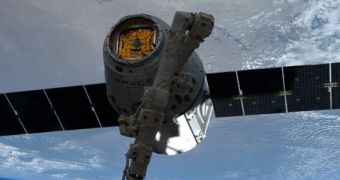Scientists at the NASA Jet Propulsion Laboratory (JPL) in Pasadena, California, have a lot riding on the latest resupply spacecraft launched into space by Space Exploration Technologies Corporation (SpaceX), of Hawthorne, California. Tucked away in the bowels of the Dragon spacecraft is the Optical PAyload for Lasercomm Science (OPALS), which seeks to test laser-based data transmissions.
This is the second laser communications device NASA sends into space in less than 6 months. At the end of last year, the agency tested the Lunar Laser Communication Demonstration (LLCD) pulsed laser system aboard its Lunar Atmosphere and Dust Environment Explorer (LADEE) spacecraft. The system successfully transmitted data over a distance of 385,000 kilometers (239,000 miles).
NASA is interested in this type of communication systems because they promise much faster data transfers and speeds than radio waves do. The LLCD system, for example, established a new record, with a downlink rate of 622 megabits per second and an upload rate of 20 megabits per second.
When OPALS is installed aboard the ISS, mission controllers on the ground will fire a laser beacon from the JPL Optical Communications Telescope Laboratory (OCTL) in Wrightwood, California, towards the International Space Station (ISS). This will allow for the precise orientation of the downlink laser towards the ground receiver.
The goal of the experiment is to relay a video from aboard the ISS towards the OCTL. The file will be broken up into pieces, each transmitted over a 2-minute interval of alignment between the space lab and the ground receiver. The two have to maintain line of sight in order for OPALS to work. All engineering data will be used to improve the next generation of optical communications systems.
“Optical communications has the promise of meeting the high data rate expectations of future scientific instruments flying on NASAs missions, and improving the interconnectivity between near-Earth assets, such as the ISS, and Earth,” NASA investigators said in a recent press release.
“OPALS is one of NASAs first demonstrations of an optical communications link from near Earth, and is designed to help chart the path for enabling optical communications in future missions. […] The investigation team plans to use this data to advance the design and performance of future lasercomm links built to support NASAs space endeavors,” the document further said.
OPALS was launched into space on Friday, April 18, aboard the third SpaceX Dragon spacecraft to undertake an ISS resupply flight. The capsule was delivered to Earth's orbit by a Falcon 9 medium-lift rocket, which took off from SLC-40 at the Cape Canaveral Air Force Station in Florida. The Dragon was grappled via the ISS' Canadarm-2 robotic arm on Sunday, April 20.
Over the next few weeks, Expedition 39 astronauts aboard the ISS will unload the capsule of its 2.5 tons of cargo and fill it up with unneeded items, tools, and experiments. The capsule will separate from the space station and splash down in the Pacific Ocean on May 18.

 14 DAY TRIAL //
14 DAY TRIAL //